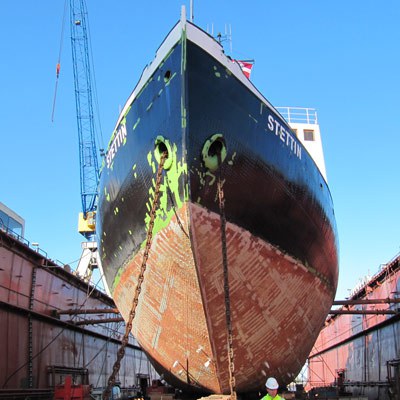Brandstwiete 1
20457 Hamburg
Oya Sönmez
Phone: +49 40 361 37-239
Fax: +49 40 361 37-204
Mobile: +49 171 88 53 239
Mail: oya.soenmez@bg-verkehr.de
BG Verkehr / Dienststelle Schiffssicherheit
Referat Schiffbau
Brandstwiete 1
20457 Hamburg
O. Köster
Phone: +49 40 361 37-322
Fax: +49 40 361 37-204
Mail: schiffbau@bg-verkehr.de
Ships of traditional build
- Definition "ship of traditional build"
- Approval
- Safe manning
- Fitness for sea service and medical care on board
- Traditional ships on international voyages
- Discussions regarding traditional ships
Not any old ship is a ship of traditional build
Colloquially, a historic ship is understood to mean older ship which appears historic to the outsider. In ship safety legislation, however, not every ship that looks traditional is indeed a ship of traditional build. Rather, it is important that the ship is preserved in its original condition or has been constructed true to the original, and that it is not commercially operated.
According to German law, ships of traditional build are historic water craft whose presentation during a voyage is in the public interest. A historic water craft is, according to the German Ship Safety Ordinance (Schiffssicherheitsverordnung), a "ship built mainly with original materials which is worthy of preservation because of its build, construction, former purpose of use and rarity, and which essentially corresponds to the original condition when it was first built or to a historically significant state of build during a commercial period of use at a later time ".
The Ship Safety Division of BG Verkehr can also recognize a rebuilding as a historic water craft where the combination of hull shape, propulsion and superstructures is not true to the original but where the overall appearance corresponds to a previous model which verifiably existed.
An individual equivalent to a historic water craft can also be:
- a replica = a single reproduction of a documented individual historic model or
- a training ship for sailing = a sailing ship of at least 24 m especially suitable for a sound training in traditional seamanship because of its size, rigging, complex ship operation as well as number of crew.
The operation of a ship of traditional build must serve non-material purposes, notably historical marine engineering and traditional seamanship must be imparted. The operators of ships of traditional build may only use the income, for example from accompanying guests, for the preservation and operation of their traditional ship.
The legal basis for ships of traditional build is the "Schiffssicherheitsverordung" (Ship Safety Ordinance), Annex 1a Part 3.
Approval as a ship of traditional build
The Ship Safety Division of the BG Verkehr is responsible for the issuance of a safety certificate for ships of traditional build. It considers in each individual case whether the criteria for approval as a ship of traditional build are met.
Upon application, the Ship Safety Division issues a safety certificate for ships of traditional build if
- the ship is a historic water craft,
- there is a public interest in the presentation during a voyage,
- it is not a commercial ship operation (the operation of the ship serves non-material purposes, especially in regard to imparting historical marine engineering and traditional seamanship, according to its utilization concept and a verification report by a financial auditor),
- surveyors of the Ship Safety Division or of a recognized classification society surveyed the ship and
- verified compliance with the provisions of the Ship Safety Ordinance
The operator is obliged to proof
- the historic nature,
- the original condition and
- the history
of the ship with data, photographs and drawings. Additionally, he must also submit an expert's report if
- the proof of the ship's history does not suffice or
- the utilization concept is inadequate or
- it is a rebuilding or replica.
The expert issuing the report that verifies these requirements has to be personally and professionally suited, reliable and impartial as well as approved by the BG Verkehr. The details are regulated in the relevant rules of procedure. The BG Verkehr has recognized the following as experts:
- Dr. Albrecht Sauer, e-mail: MarHistDoc@gmx.de
The safety certificate for ships of traditional build is valid for five years. In addition to the initial and renewal survey, an intermediate survey between the second and third year of the certificates term is required.

Safe manning for ships of traditional build
Masters of ships of traditional build need not hold certificates of competency as required in merchant shipping. Depending on the ship’s length and the cruising area the Sportseeschifferschein (license for offshore cruising) and the Sporthochseeschifferschein (licence for ocean cruising) (from 25 m length of the vessel with the additional entry "traditional shipping") are sufficient. Safe manning for ships of traditional build is regulated with the German "Sportseeseeschifferscheinverordnung" (Ordinance on cruising licences). It also gives detailed information about the required crew for traditional ships.
Fitness for sea-service and maritime care on board ships of traditional build
On ships of traditional built crew members being part of the safe manning and whose capacity is listed in the Minimum Safe Manning Document (inter alia master, mate, machinist) have to be fit for sea service. Details on this are given in our information "Seediensttauglichkeit für Besatzungsmitglieder von Traditionsschiffen" (in German only).
On ships of traditional built at least one person on board has to be responsible for the medical care on board the ship on each voyage (from 80 persons on board two persons responsible). These persons are required to have particular skills and knowledge depending on the trading area of the traditional vessel:
- within coastal maritime waters: basic refresher course (16 hours) or license to practice as a physician or training as emergency medical technician or paramedic,
- outside of coastal maritime waters: advanced refresher course (40 hours) or license to practice as a physician.
The voyage within coastal maritime waters includes any sea up to 30 nautical miles distance from the mainland coast as well as the maritime areas of the Baltic and North Sea, the Channel, the Bristol Channel, the Irish and Scottish Sea, the Mediteranean Sea and the Black Sea (German "Sportseeschifferscheinverordnung" Sec. 1 Para. 2 Sent. 2).
Additionally, ships of traditional build must be equipped with medical equipment according to the State of medical knowledge.
Find out more about this in our section on "Maritime Medicine".
Traditional ships on international voyages
Ship safety certificates of the BG Verkehr for traditional ships are national certificates. They do not have to be recognized by foreign states because there are no mandatory international or European regulations. International voyages require the agreement of the port state which the operator has to obtain.
Discussions regarding traditional ships
Repeatedly, discussions regarding the approval of a ship of traditional build have been reported by the press. Some owners of older ships blame the responsible Ship Safety Division of the BG Verkehr for being too restrictive in its approval practice. What are the reasons for these discussions and what are they about?
Ships of traditional build are privileged, in legally strictly defined areas, compared to commercial passenger ships: due to their design and construction, these ships need not meet all safety requirements applicable to modern passenger ships. Furthermore, masters of ships of traditional build do not need the certificates of competency required in commercial shipping. Nevertheless, ships of traditional build frequently carry many passengers which are entitled to the same safety standards as applicable to commercial passenger ships. Therefore, approval as a ship of traditional build must be restricted to ships whose preservation and operation serves a public interest (protection of the maritime heritage). Otherwise passenger ships operating under stricter terms would be discriminated against. Even for operators of historic ships it is important that not any old ship benefits from unfair privileges. Over the last few years, the approval practice of the Ship Safety Division has been confirmed by the administrative court and the Higher Administrative Court on several occasions.
If the Ship Safety Division of the BG Verkehr dismisses an application of a ship operator to issue, renew or reinstate a certificate for a ship of traditional build, he or she can turn to the ombudsoffice for navigation with traditional ships (Ombudsstelle für die Traditionsschifffahrt). The two ombudspeople, Dr. Valerie Wilms (former member of the Bundestag and traffic expert of the party "die Grünen") and Prof. Dr. Dr. h.c. Peter Ehlers (former president of the Federal Maritime and Hydrographic Agency, BSH), mediate upon application and after a verification of the responsibility between the ship operators and the BG Verkehr as the approval authority. The procedure with the ombudsoffice does not replace an opposition proceeding and is excluded from any interim legal protection applied for at an administrative court. The ombudsoffice presents a conciliatory proposal to the parties to the proceedings which is not binding. The details of the conciliation proceedings are regulated by rules of procedure.

